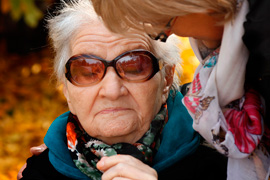August 18th, 2016
The Caregiver Conundrum
Charity Maniates, MSPA, MPH, PA-C
My patient’s daughter, Jane, sits tensely on the edge of the wingback chair. Leaning forward slightly, her body, like a jack-in-the-box, stays seated, and she fires the question, “Do you really think my mother is ready to come home? Is this safe?”
Rippling beneath her intense body language and direct questioning is a pervasive fear that a catastrophe will occur if she brings her mother home. This anxiety swirls and lingers when families visit and observe loved ones struggling. My softly couched reply is concise: after a hip fracture, elders may have difficulty returning to their previous baseline. Embedded in this simplistic response are many variables impacting progress: comorbidities, dementia, fragility, and medications. Data show that elders with hip fractures experience increased infections and an increased risk of death within one year.
Jane’s 87-year-old mother, a woman with an indelible smile and sweet disposition, speaks only a few words and sentences due to advanced dementia. A few weeks earlier, a simple trip at home resulted in a hip fracture, a visit to the ED, and surgery. Although the hip repair was uneventful, pain impeded her progress. During rehab, it became apparent to her daughter that she requires assistance with transfers and ambulation and cannot be left alone, even for a few hours — a terrifying prospect for a caregiver overwhelmed with the emotional and financial responsibility of 24-hour care and work responsibilities. 
Jane continues to talk, rapidly, as though the solution will unveil itself at some point in her thoughts. Although she has ample supports in place — an adult daycare program and home companions — she works full time and travels, and leaves her mother home alone for a few hours or overnight with an aunt who has mild dementia. Now, she will not be able to do this. I delicately probe, asking what is her most pressing concern. She leaps at the question and says, “I’m the only one to take care of her. What happens if I collapse and can’t do this? What will happen to her?” I don’t have a good answer. Nor am I able to offer any long-term resources she has not accessed aside from nursing home care.
She is far from alone in her quandary. Of the massive cohort of 65+ adults that is growing exponentially, an estimated two-thirds will require long-term care (Kemper, Komisar, & Alecxih, 2005–2006), and nearly half will spend time in a nursing home (Spillman & Lubitz, 2002). Moreover, the average 65-year-old will spend $138,000 in future long-term-care service costs (Favreault & Dey, 2015), and those with dementia will incur substantially higher costs. Although nursing home care is primarily covered by Medicare and Medicaid, these massive structures must be bolstered through changes in policy and funding to sustain the growing demand for long-term care. For instance, legislation reintroduced in February of 2015 by Congresswoman Jan Schakowsky (D-IL) proposes increasing registered nurser (RN) coverage from the current federal mandate of only 8 hours daily to 24 hours/7 days a week. This would potentially improve quality of care, improve the ability to respond and assess patients, and allow for more personalized care that families and patients seek. If the act passes, nursing homes would receive Medicare and/or Medicaid reimbursement for the expanded RN coverage and would ultimately see improvement in quality care measures.
So, lacking a solution for her, I take a moment to validate her role as the primary caregiver and recognize how overwhelming it is. Pausing intentionally, I gently ask her if she’s ever considered an alternative such as long-term care. Inwardly, I cringe, wanting to offer a polished program or eco-friendly housing, rather than an institutionalized structure, to replace the personal care that a doting daughter has provided for years.
Her shoulders and head droop, and she can’t hold back the tears. “I feel so guilty! I told my mother she may not be able to stay at home, but that’s all she wants!” Guilt. A powerful driving force that keeps caregivers from placing a loved one in institutionalized care. And it’s quite understandable that caregivers have difficulty releasing their loved ones to a system trying to respond to the needs of the many, which cannot provide care with the caregiver’s intimate knowledge of a subtle tone of voice, a facial expression, or a favorite food. But the extensive tasks required to care for an elder with advancing dementia are taxing 365 days, year after year. Every aspect of care requires assistance: eating, drinking, toileting, dressing, and medication management. The tradition of elders living their last days in the family home is dwindling, and the only options are nursing home care and private care at home for those with financial resources. Both options can deplete a lifetime of savings quickly for the majority of working class families.
Our conversation starts to wind down, and she looks relieved that she vocalized her concerns and that I validated her deep-rooted fears. Taking a deep breath, she says, “Only time will tell if she improves, and I’ll go from there.” Grasping my hand tightly, she thanks me for talking. I smile, telling her that if her mother is not doing well at home, she should call the facility and her mother could return to skilled care. It’s the only short-term option I can offer her — providing a few extra days or weeks of care.
Turning to walk away, I glimpse her mother eating at the dining room table, and for a few minutes, I find solace in the fact that I was able to provide brief support to an overextended caregiver. The feeling is fleeting. I sigh sadly, knowing that Jane will be placing her mother inside the unfamiliar walls of a nursing home within a few months.
References
Favreault M, Dey J. Long-term services and supports for older Americans: Risks and financing. ASPE Research Brief. 2015.
Harris-Kojetin L, Sengupta M, Park-Lee E, et al. Long-term care providers and services users in the United States: Data from the National Study of Long-Term Care Providers, 2013–2014. National Center for Health Statistics. Vital Health Stat 3(38). 2016.
Kemper P, Komisar HL, Alecxih L. Long-term care over an uncertain future: What can current retirees expect? Inquiry 42(4):335–50. 2005–2006.
Spillman BC, Lubitz J. New estimates of lifetime nursing home use: Have patterns of use changed? MedCare 40(10):965–75. 2002.



Is a task complex advise to a caregiver which is the best option for his/her parent that need care or supervision in the tasks of the daily living. Much more when appears a dementia as in the case described.
The difficulty is increased when we, as professionals, are aware that the quality and warmth of the care in an institution are very distant from those offered in the home.
The solution and the advice that we can give to those caregivers is complex and difficult.
Is possible that from the political and organizational point of view, it should rethink some aspects. Taking into account the high cost that will in the future the attention to population aged with functional impairment, and that would permanent institutionalisation, is necessary to assess the possibility of improving the social and healthcare, supported with professionals trained and motivated, to offer care and supervision 24 h, 365 days a year.
Elders usually want to be at his home, and relatives are generally reluctant to permanent institutionalization of their loved ones. Us face to a task long and hardy, and the solution is not easy, but our modern society of the welfare should try to improve the quality of the social and health support in home of our elderly and of their informal caregivers.
Thank you Dr. Fernandez-Viadero for taking the time to read my post. Your comments are thoughtful and very accurate of the realities of this complex issue. Care of failing elders is a costly endeavor but shouldn’t be the reality that it is. My hope is that political action and mobilization within the medical community will occur to ensure our elders and their caregivers are given viable options for quality care as our nation ages.